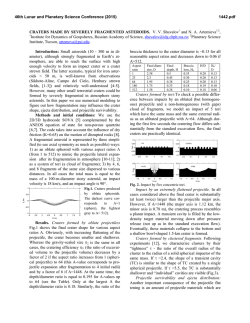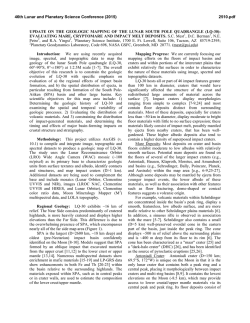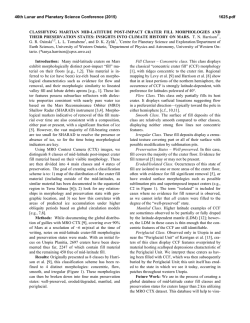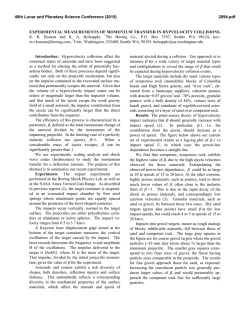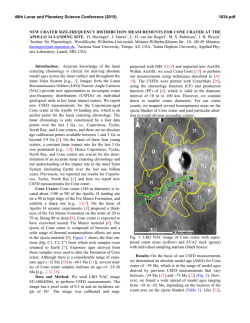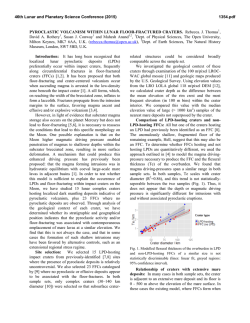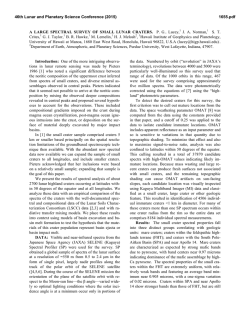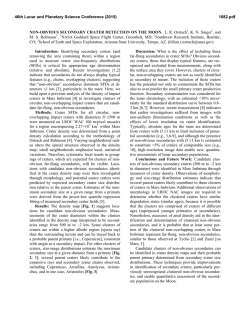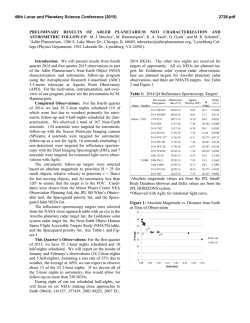
HEATING OF PROJECTILE MATERIAL DURING LOW VELOCITY
46th Lunar and Planetary Science Conference (2015) 1173.pdf HEATING OF PROJECTILE MATERIAL DURING LOW VELOCITY IMPACTS ON THE MOON. V. V. Svetsov1 and V. V. Shuvalov, Institute for Dynamics of Geospheres, Russian Academy of Sciences, Leninskiy Prospekt 38-1, Moscow, 119334, Russia, [email protected]. low impact velocities, a substantial part of it remains in the crater. Figure 1 shows the relative masses of projectile materials (dunite and quartz) that are heated to temperatures below 600, 1000, and 1200 K and remain in the crater. In small craters, the projectile is dispersed across the crater floor, and in complex craters, much of the projectile debris can be swept back to the central peak by the collapse flow [9]. 0.5 Dunite Mass fraction 0.4 Total 0.3 1.2 Unm 1 0.2 0.6 0.1 0 6 7 8 9 10 11 12 13 14 Impact velocity, km/s 0.8 Quartz Total Mass fraction Introduction: Several recent missions detected water signals from the Moon surface. The measurements by Lunar Exploration Neutron Detector on the Lunar Reconnaissance Orbiter spacecraft show some regions at the lunar south pole with enhanced hydrogen content [1]. These regions do not correlate with permanently shadowed areas at the bottom of polar craters and are observed in both permanently shadowed and illuminated areas [2]. Significant epithermal neutron flux suppressions were detected at Cabeus, Haworth and Shoemaker craters [3]. These data suggest that lunar water could be delivered to some craters by comets and water-bearing asteroids. Release of water from hydrated meteorites depends on the temperature to which a projectile is heated during the impact. Here we use a numerical model for simulations of the impacts of asteroids in order to estimate the temperature of projectile material and the fate of water contained in it. Assumptions: We assume that water can be delivered to the Moon by hydrous minerals included in asteroids similar to carbonaceous chondrites, such as CI, CM, and CR groups, with the water content making up roughly 10% of the meteorites on average. Studies of phyllosilicates in carbonaceous chondrites show that the hydrated minerals do not begin to decompose until they reach temperatures of about 600–700 K [4]. The highest temperatures of complete dehydration of serpentine and saponite with formation of olivine and enstatite are from 1100 to 1200 K [5]. We used this temperature levels as indicators of dehydration degree. Impact simulations: We exploited a computer code SOVA [6] for two- and three-dimensional hydrodynamic simulations. Using tracer particles for projectile material, we determined the maximum temperatures and position of material after crater formation. The impact velocities of asteroids varied from 6 to 14 km/s, in this case the bulk of a projectile can remain solid [7], and, on the other hand, approximately 25-30% of asteroid impacts on the Moon occur at velocities less than 12 km/s [8, 9]. We have no equation of state for carbonaceous material, and used instead available equations of state for some rocks. We approximated the projectile as dunite (density 3.3 g/cm3) and quartz (density 2.5 g/cm3) and the target as quartz, and used ANEOS equation of state. The diameter of projectiles was 1 km. Results of simulations: Material of an impactor can be ejected far from the crater and escape, but at 0.6 Unm 0.4 Total 0.2 Unm 1.2 0.6 1 0 6 7 8 9 10 11 12 Impact velocity, km/s Fig. 1. Fraction of projectile material remaining within the crater: total, unmelted, and heated below given temperature levels, 0.6, 1, and 1.2 kK (1 kK=1000 K). The solid lines show results for oblique impacts at 45°, and the dashed lines show vertical impacts. At the most probable impact angle 45°, some amount of phyllosilicates can survive the impacts up to an impact velocity of 11 km/s. At a velocity of 7 km/s about 15% of an impactor mass is heated below 600 K in the case of a quartz projectile and about 30% in the case of a dunite projectile; only molecular water can release from this mass fraction. A 10-km-diameter crater produced by the impact of a 1-km-diameter asteroid at 7 km/s can contain a layer of impactor material about 20 m thick, including more than 5% of wa- 46th Lunar and Planetary Science Conference (2015) ter. Some portion of impactor material remains unmelted at high speeds when the heating of material exceeds the threshold of complete dehydration of the minerals. Therefore, if the body is broken up into relatively large fragments, the water can remain in the solid fragments, despite the temperature of the fragments is above 1200 K. According to our simulations, at the impact angle of 45° complete melting of a quartz projectile takes place only at an impact speed of about 13 km/s. Proportion of hydrated asteroids: According to the catalog [10], the falls of CI, CM, and CR meteorites make up about 3% of the total falls of stony bodies on the Earth. Probably this relative number is smaller than the number of carbonaceous chondrite impacts on the Moon because other stony bodies, such as ordinary chondrites, are stronger and easier survive the passage through the Earth’s atmosphere. Asteroids of C- and Ptypes, presumably analogues of the dark CI and CM carbonaceous chondrite meteorites, make up more than half main-belt and Trojan asteroids by mass if we exclude four most massive asteroids [11]. About twothirds of C-type asteroids have hydrated silicate surfaces [12]. The relative number of hydrated asteroids grows with the distance from the Sun; however, the population of near-Earth objects (NEO) is replenished primarily from the inner regions of the main belt. According to the estimates [13], about 24% of NEO population come from the central main belt, ~8% come from the outer main belt, and ~6% come from the Jupiter-family comet region The estimated relative number of C-class asteroids among Earth-approaching asteroids is from about 15 % [14] to 30% [15]. Assuming that two-thirds of them are hydrated [12] we estimate that the relative number of hydrated asteroid impacts on the Moon is 10-20%. Low velocity impacts are not frequent: about 25% of lunar impacts occur at speeds below 12 km/s, about 15% of the impacts occur at speeds below 10 km/s, and only 1.5% occur at speeds below 6 km/s [8, 9]. Assuming that some fraction of hydrated material survives the impact at speeds below 10 km/s we estimate that from 2% to 4.5% of asteroidal craters can contain hydrated material from meteorites. This chemically combined water can exist even in the craters illuminated by the Sun. Experimental impacts on the Moon: The impact of Lunar Prospector (mass 160 kg, velocity 1.7 km/s) into the shadowed floor of the Shoemaker crater revealed no water [16]. Such a low velocity is insufficient to release water if it is in the form of hydrated minerals. In the Lunar Crater Observation and Sensing Satellite (LCROSS) mission, a rocket with a mass of 2400 kg struck a shadowed region within the lunar south pole crater Cabeus at a velocity of 2.5 1173.pdf km/s, ejecting debris, dust, and vapor [17]. The total mass of water vapor and water ice within the field of view of the instrument on board the second spacecraft was estimated as 155 ± 12 kilograms [17]. As the speed of 2.5 km/s is insufficient for dehydration of minerals, it is likely that the LCROSS impact ejected free water contained in the regolith. Since the comet impacts are rarer and deliver little water to craters, the water in the Cabeus crater with greater probability could be released from hydrated material of an asteroid which produced this crater. Conclusions: We find that at impact velocities below 10 km/s the bulk of a stony projectile remains unmelted, a portion of it is heated to temperatures below 1000 K, and hydrous minerals only partly decompose. Along with the implantation of hydrogen from solar wind and condensation from water vapor transient atmospheres produced by high velocity impacts of comets and asteroids, low velocity impacts of hydrated asteroids can deliver water to the whole Moon surface and, moreover, can produce high concentrations of hydrogen in the craters both in the form of water ice and chemically bound water. Note that the impacts with an average velocity about 5 km/s are typical for collisions among the main belt asteroids. Many large asteroids similar in composition to ordinary chondrites may have spots of hydrated material at the surface due to collisions with water-rich objects from the outer regions of the Solar system. The work was supported by the Russian Foundation for Basic Research, project no. 13-05-00694-a. References: [1] Mitrofanov I. G. et al. (2010) Science, 330, 483–48. [2] Mitrofanov I. G. et al. (2012) J. Geophys. Res., 117, E00H27. [3] Sanin A. B. et al. (2014) LPS XLV, Abstract #1358. [4] Akai J. (1992) Proceedings of the NIPR Symposium on Antarctic Meteorites 5, 120–135. [5] Ivanova M. A. et al. (2010) Meteoritics & Planet. Sci., 45, 1108–1123. [6] Shuvalov V. V. (1999) Shock Waves, 9, 381–390. [7] Potter R. W. K. and Collins G. S. (2013) Meteoritics & Planet. Sci., 48, 744–757. [8] Marchi S. et al. (2009) Astrophys. J., 137, 4936–4948. [9] Yue Z. et al. (2013) Nature Geoscience, 6, 435–437. [10] Grady M. M. (2000) Catalogue of Meteorites. Cambridge Univ. Press, Cambridge. [11] DeMeo F. T. and Carry B. (2013) Icarus, 226, 723–741. [12] Jones T. D. et al. (1990) Icarus, 88, 172–192. [13] Bottke W. F. et al. (2002) Icarus, 156, 399–433. [14] Lupishko D. F. and Lupishko T. A. (2001) Sol. Sys. Res., 35, 227–233. [15] Shoemaker E. M. et al. (1990) Geol. Soc. America Spec. Paper, 247, 155–170. [16] Goldstein D. B. et al (2001) J. Geophys. Res. 106, 32841–32846. [17] Colaprete A. et al. (2010) Science, 330, 463–468.
© Copyright 2025

